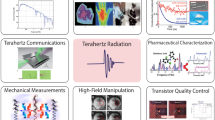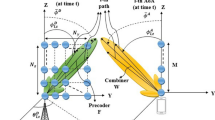Abstract
Single-channel bidirectional synthetic aperture radar (BiDi-SAR) systems require the pulse repetition frequency (PRF) to be cautiously designed. Firstly, it should be higher than the total bandwidth of the two Doppler subbands; secondly, it should be carefully selected so that the two Doppler subbands are properly located. We introduce multichannel BiDi-SAR imaging mode to realize bidirectional high resolution wide swath (HRWS) imaging. Acquisition geometry of multichannel BiDi-SAR is interpreted. Doppler spectrum of BiDi-SAR consists of two subbands with limited bandwidth. Based on a prior knowledge about the location of the Doppler subbands, we derive the method for separating the aliased Doppler spectra for general PRFs. Then, we analyze the reconstruction performance in terms of azimuth ambiguity to signal ratio (AASR) and signal to noise ratio (SNR). Besides, we propose to use a properly designed sparse array antenna to improve the azimuth ambiguity performance. Validity of the signal processing method is verified by simulation results.
创新点
单通道双指向合成孔径雷达 (BiDi-SAR) 对系统PRF有着较为苛刻的要求: 首先, 系统PRF必须高于多普勒谱总带宽; 其次, 所选择的PRF应当能够使得卷绕到基带的两个多普勒子频带正好错开, 从而通过带通滤波将与前后两个波束想对应的两个多普勒子频带予以分离。本文提出多通道BiDi-SAR观测模式以实现双指向高分辨率宽测绘带 (HRWS) 宽测。对多通道BiDi-SAR模式的工作原理进行了阐释。基于BiDi-SAR多普勒谱的各子频带位置的先验性息, 推导了适用于一般PRF条件的多普勒谱分离方法。对方位模糊比 (AASR) 以及信噪比 (SNR) 等关键的重建性能进行分析, 给出了解析表达式。此外, 提出利用稀疏阵列天线实现天线方向图的优化从而实现BiDi-SAR AASR性能的提升。
Similar content being viewed by others
References
He F, Chen Q, Dong Z, et al. Modeling and high-precision processing of the azimuth shift variation for spaceborne HRWS SAR. Sci China Inf Sci, 2013, 56: 102304
Curlander J C, McDonough R N. Synthetic Aperture Radar-Systems and Signal Processing. New York: John Wiley & Sons, 1991
Stangl M, Werninghaus R, Schweizer B, et al. TerraSAR-X technologies and first results. IEE Proc-Radar Sonar Navig, 2006, 153: 86–95
Pitz W, Miller D. The TerraSAR-X satellite. IEEE Trans Geosci Rem Sens, 2010, 48: 615–622
Frasier S J, Camps A J. Dual-beam interferometry for ocean surface current vector mapping. IEEE Trans Geosci Rem Sens, 2001, 39: 401–414
Mittermayer J, Wollstadt S. Simultaneous bi-directional SAR acquisition with TerraSAR-X. In: Proceedings of 8th European Conference on Synthetic Aperture Radar, Aachen, 2010. 1–4
Mittermayer J, Prats P, Wollstadt S, et al. Approach to velocity and acceleration measurement in the bi-directional SAR imaging mode. In: Proceedings of IEEE International Geoscience and Remote Sensing Symposium, Munich, 2012. 5618–5621
Mittermayer J, Prats P, López-Dekker, et al. Bidirectional SAR imaging mode. IEEE Trans Geosci Rem Sens, 2013, 51: 601–614
Currie A, Brown M A. Wide-swath SAR. IEE Proc-F Rad Sig Proc, 1992, 139: 122–135
Krieger G, Gebert N, Moreira A. Unambiguous SAR signal reconstruction from nonuniform displaced phase center sampling. IEEE Geosci Rem Sens Lett, 2004, 1: 260–264
Li Z, Bao Z, Wang H, et al. Performance improvement for constellation SAR using signal processing techniques. IEEE Trans Aerosp Electron Syst, 2006, 42: 436–452
Gebert N, Krieger G, Moreira A. Digital beamforming on receive-techniques and optimization strategies for highresolution wide-swath SAR imaging. IEEE Trans Aerosp Electron Syst, 2009, 45: 564–590
Kim J H, Younis M, Prats P, et al. First spaceborne demonstration of digital beamforming for azimuth ambiguity suppression. IEEE Trans Geosci Rem Sens, 2013, 51: 579–589
Mailloux R J. Phased Array Antenna Handbook. Norwood: Artech House, 1994
Oppenheim A V, Schafer R W, Buck J R. Discrete-Time Processing. Upper Saddle River: Prentice-Hall, 1999
Cumming I G, Wong F H. Digital Processing of Synthetic Aperture Radar Data: Algorithm and Implementation. Norwood: Artech House, 2005
Van Trees H L. Optimum Array Processing: Part IV of Detection, Estimation, and Modulation Theory. New York: Wiley Interscience, 2002
Kay S M. Fundamentals of Statistical Signal Processing: Estimation Theory. Upper Saddle River: Prentice-Hall, 1993
Zhang X. Matrix Analysis and Applications. Beijing: Tsinghua University Press, 2004
Author information
Authors and Affiliations
Corresponding author
Rights and permissions
About this article
Cite this article
Ma, X., Dong, Z., He, F. et al. Spectrum reconstruction and the performance analysis for multichannel bidirectional SAR. Sci. China Inf. Sci. 58, 1–13 (2015). https://doi.org/10.1007/s11432-014-5265-7
Received:
Accepted:
Published:
Issue Date:
DOI: https://doi.org/10.1007/s11432-014-5265-7
Keywords
- bidirectional synthetic aperture radar (BiDi-SAR)
- multichannel
- sparse array antenna
- spectrum reconstruction
- performance analysis




